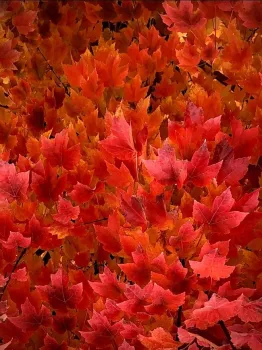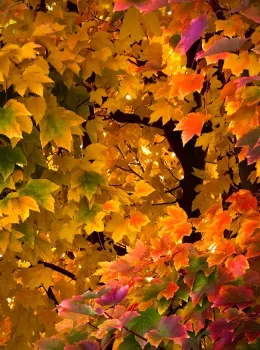
Many people believe that frost is responsible for the change in colors, but frost has little to do with it. Many times, leaves change color before the first hint of frost.
According to Native American legend, celestial hunters killed the Great Bear Autumn, and the spattered blood turned the leaves red. Furthermore, the yellow of fall came from the fat splashing out of the pot as the hunters cooked their kill. There are many more legends, but scientists have toiled to comprehend the fluctuations in trees and shrubs during fall for ages.
Autumnal leaves in vibrant hues are a beautiful part of the season, but those leaves are also vital to keeping trees alive. Trees that have leaves that change color in fall are deciduous.
Today, we know three factors influence autumn leaf color: Leaf pigments, night length, and weather. In addition, some changes result from chemical processes in the trees as the growing season ends. Chlorophyll gives leaves a primary green color. Also essential for photosynthesis is the chemical reaction that enables shrubs and trees to use sunlight to produce sugars for food.
As the autumn days decline, the reduced daylight tells deciduous plants that it is time to stop gathering energy and prepare for winter's dormant season. Trees get less sunlight, and the chlorophyll in the leaves breaks down. Consequently, the lack of chlorophyll exposes yellows and orange pigments already in the leaves but masked during the warmer months. Both chlorophyll and carotenoids are present in the chloroplast of leaf cells throughout the growing season.

The brilliance of the color that develops in any particular autumn season is related to climate conditions that occur before and during the time the chlorophyll is decreasing. Temperature and humidity are the key influences. A sequence of warm, sunny days and cool, but not freezing nights seems to bring about the most impressive shows. During these days, lots of sugars develop in the leaf, but the cool night and gradual closing of the veins going into the leaf prevent these sugars from moving out. They are water-soluble and appear in the watery liquid of leaf cells.
These conditions - lots of sugar and light - spur production of the brilliant anthocyanin pigment, which tints reds, purples, and crimson. Anthocyanin colors cranberries, red apples, blueberries, cherries, and plums. Some trees, like Black Tupelos, Dogwood, and Pistache, will likely produce crimson to scarlet red leaves.
Furthermore, the amount of moisture in the ground also affects fall colors. Like the climate, soil moisture varies significantly yearly. The myriad patterns of these two highly variable factors guarantee that no two autumns are alike. The timing of color changes fluctuates within species and seems innately inherited. The same species will display a similar color scheme in cool temperatures in higher elevations at nearly the same time as in warmer lower climates.
Leaves can change color from mid-September through early November. The peak times are usually the second and third weeks of October, but this depends on local weather conditions.
It is worthwhile considering the likely effect of climate change on the occurrence of autumn foliage coloring. Existing evidence supports the view that environmental changes will hinder the onset of fall leaf coloring.
For more information, please visit:
https://www.ucdavis.edu/news/where-see-fall-foliage-uc-davis
https://ucanr.edu/blogs/blogcore/postdetail.cfm?postnum=58156

